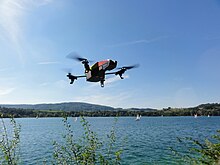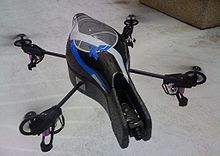Parrot AR.Drone
The Parrot AR.Drone is a remote-controlled quadrocopter from the French manufacturer Parrot SA .
The drone can be controlled by the user via a mobile app , which is available for Apple iOS and Android .
Design and development
The AR.Drone was first presented at the International Consumer Electronics Show in Las Vegas in 2010. There she won the CES Innovations Award for Electronic Gaming Hardware . Parrot will present the second version of the drone at CES in Las Vegas 2012. Among other things, this offers an improved camera and more sensors.
At CES 2013, Parrot announced new features for the drone. A flight recorder was presented. This has a GPS module to display flights in 3D and enable autonomous flights. The device also has 4 GB of memory for videos. A new 50% stronger battery was also announced. The app should also be revised and allow better filming and editing of videos.
Using Wi-Fi , the aircraft can with an app that for smartphones and tablet PCs with the operating systems Apple iOS or Android is available can be connected and controlled and sends in parallel images of the two cameras on the device. There are also several unofficial apps available for bada , Symbian and Windows Phone .
FreeFlight
FreeFlight is the name of the app that can be used to control the drone and record videos. The videos and photos recorded in this way can be immediately shared with the software on YouTube and Picasa .
Since the app was updated in July 2012, it has also been possible to compete with other AR.Drone owners via the so-called AR.Drone Academy . The social network can be used directly from the app.
Technical specifications
| model | AR.Drone | AR.Drone 2.0 | |
|---|---|---|---|
| processor | 468 MHz ARM9 | 1 GHz 32-bit ARM Cortex A8 + 800 MHz digital video processor from Texas Instruments |
|
| random access memory | 128 MB DDR RAM (200 MHz) | 1 GB DDR2 RAM (200 MHz) | |
| Cameras | Front | 93 ° with QVGA (30 fps) | 92 ° with 720p (30 fps) |
| Below | 64 ° (60 fps) | QVGA (60 fps) | |
| battery | 1000 mAh lithium polymer battery with 11.1 volts & high density 1500 mAh lithium polymer battery | ||
| Flight duration | ~ 12 minutes | ||
| Sensors | gyroscope | biaxial gyroscope | triaxial gyroscope |
| Magnetometer | no | three-axis magnetometer | |
| Accelerometer | three-axis accelerometer | ||
| Distance sensor | Ultrasound up to 6 meters | Ultrasound up to 6 meters + air pressure sensor |
|
| connections | no | USB port | |
| operating system | Linux | ||
| Connectivity | Wi-Fi b / g | Wi-Fi b / g / n | |
| Dimensions | Indoor shell | 52.5 cm × 51.5 cm | |
| Outdoor cover | 45 cm × 29 cm | ||
| Weight | Indoor shell | 420 grams | |
| Outdoor cover | 380 grams | ||
| Engines | 4 brushless internal rotor motors (15 watts / 35,000 rpm) |
4 brushless internal rotor motors (14.5 watts / 28,500 rpm) |
|
The drone's capabilities include 3D environment recognition , compatibility for AR game applications, and an altitude meter for controlled hovering in windy conditions.
The two body shells supplied are made of polypropylene foam (expanded polypropylene / EPP). The four propellers with their motors and gears are mounted on a cross made of carbon fiber tubes.
The AR.Drone has several sensors that are attached under the fuselage. This includes a microsystem-based miniaturized inertial navigation unit. This enables flight maneuvers such as pitching , rolling and yawing .
Other inertia meters are responsible for the automatic stabilization of the maneuvers and assisted inclination control. This creates realistic AR effects. Ultrasonic telemetry enables height measurement and automatic height stabilization as well as assisted speed control.
Augmented Reality games
For the AR.Drone, five games are optionally available from the manufacturer. These include a multiplayer combat simulation called AR.FlyingAce and AR.Rescue , a single player game in which you have to fight against aliens.
The manufacturer launched its AR.Drone API developer platform to help studios and developers develop games for the drone.
Research and training
Since the aircraft is inexpensive to obtain, offers a wide range of sensors and is provided with an open program interface, the AR.Drone is becoming increasingly popular as a platform for research and training. It has been used to experiment with visual autonomous navigation, machine learning , autonomous monitoring, human-machine interaction, and even as a sports training assistant.
monitoring
Occupy Wall Street complainant Tim Pool configured one of the devices, which he referred to as the Occucopter , for the purpose of police surveillance by citizens. He tried to get a stable live feed to allow 50 people to control the device at the same time. As soon as the police noticed this control through a computer, they could prevent this, but the control would automatically switch to another person. Using a cellular standard (such as LTE ) it would even be possible to control such a drone from another country. This would greatly expand the possibility of an invasion of privacy.
See also
Web links
Individual evidence
- ↑ AR.Drone for Android and multiplayer games
- ↑ http://blog.parrot.com/2012/01/09/ardrone2_ces2012/
- ↑ http://ardrone2.parrot.com/usa/
- ↑ Parrot AR.Drone 2.0 - Films from a bird's eye view , test.de , accessed on July 14, 2012
- ↑ http://de.engadget.com/2012/03/04/quadrocopter-parrot-ar-drone-fliegt-auch-mit-windows-phone-vide/
- ↑ https://itunes.apple.com/de/app/freeflight/id373065271?mt=8
- ↑ Annika Demgen: AR.Drone Academy: Social network for drone pilots available. In: netzwelt. August 1, 2012, accessed August 2, 2012 .
- ↑ http://ardrone.parrot.com/parrot-ar-drone/en/technologies
- ↑ http://ardrone2.parrot.com/ardrone-2/specifications/
- ↑ http://www.nytimes.com/aponline/2010/01/08/business/AP-US-TEC-Gadget-Show-iPhone-Helicopter.html?_r=1&scp=1&sq=Parrot%20AR.Drone&st=cse
- ↑ http://diydrones.com/profiles/blogs/parrot-ardrones-specs-arm9
- ↑ Archive link ( Memento of the original from January 23, 2013 in the Internet Archive ) Info: The archive link was inserted automatically and has not yet been checked. Please check the original and archive link according to the instructions and then remove this notice.
- ↑ http://labe.felk.cvut.cz/~tkrajnik/ardrone/
- ↑ http://www.cs.cornell.edu/~asaxena/MAV/saxena_MAV_perspectivecues_stairs.pdf
- ↑ http://www.cs.cornell.edu/courses/cs6780/2010fa/projects/bills_yosinski_cs6780.pdf
- ↑ http://labe.felk.cvut.cz/~tkrajnik/articles/icr10.pdf
- ↑ https://dspace.ucalgary.ca/bitstream/1880/48457/1/2011-998-10.pdf
- ↑ http://dl.acm.org/citation.cfm?id=1959833
- ↑ https://www.youtube.com/watch?v=HgWU8nXITKA
- ^ OWS Fights Back Against Police Surveillance by Launching "Occucopter" Citizen Drone , Noel Sharkey, Sarah Knuckey, AlterNet , December 22, 2011


